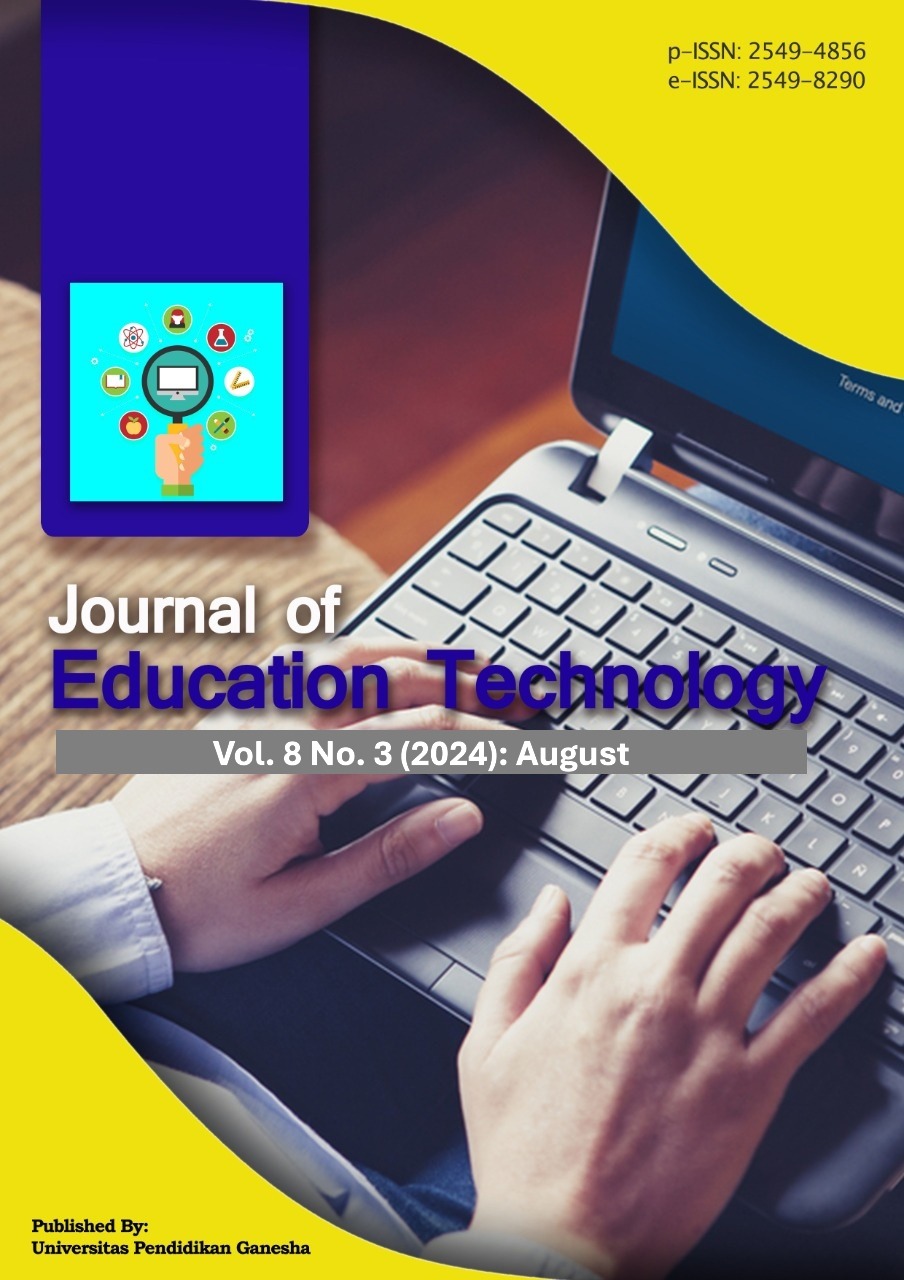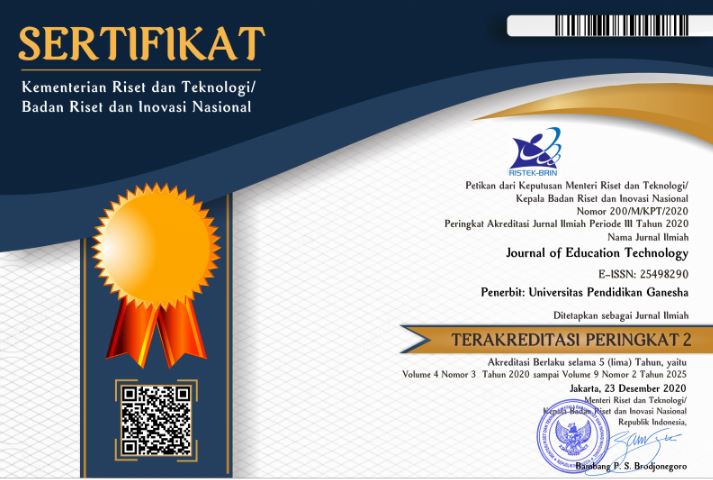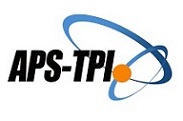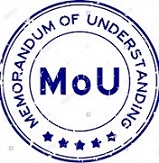The Effect of Problem Based Animated Learning Video on Science Content
DOI:
https://doi.org/10.23887/jet.v8i3.68999Keywords:
Animated Video, IPA, Problem based learningAbstract
The results of observations and preliminary research show that the background to several problems is the lack of use of creative learning media so that students are less active and less interested in learning so there is a lack of interaction between teachers and students. This is caused by teachers who still do not understand the use of technology in providing learning media for students. The solution to overcome this problem is the need to use creative and innovative learning media in schools to support the learning process. This development research aims to develop animated learning videos based on problem based learning. This research uses the ADDIE (analyze, design, development, implementation, and evaluation) model. Data collection used questionnaire and test methods. The test subjects for this research were learning content experts, learning design experts, learning media experts, individual tests, small group tests and students. The data analysis techniques used in this research are qualitative descriptive analysis techniques, quantitative descriptive analysis techniques, and t-test inferential statistics. This development research includes the results of: (1) design and development of learning videos, namely the stages of analysis, design, development, implementation and evaluation; (2) product trial results, namely: Assessment from learning design experts, namely 95% (very good), individual trial results, namely 87.2% (very good) and small group trial results, namely 80% (very good); (3) animated learning videos are effectively used to improve learning outcomes.
References
Adifta, E. D., Murni, A., & Roza, Y. (2022). Desain Perangkat Pembelajaran Daring Menggunakna Model Problem Based Learning dengan Pendekatan STEAM pada Materi Barisan dan Deret. PRISMA (Prosiding Seminar Nasional Matematika), 98–105. https://journal.unnes.ac.id/sju/index.php.
Aluintany, V. G., & Bektiningsih, K. (2024). Interactive Game Learning Media Based on Canva on Five Sensory Materials for Grade IV Elementary School. Jurnal Ilmiah Sekolah Dasar, 8(1), 186–192. http://www.jurnalfkip.unram.ac.id/index.php/JPM/article/view/6668.
Arliza, R., Setiawan, I., & Yani, A. (2019). Pengembangan Media Pembelajaran Interaktif Berbasis Android Materi Budaya Nasional Dan Interaksi Global Pendidikan Geografi. Jurnal Petik, 5(1), 77–84. https://doi.org/10.31980/jpetik.v5i1.493.
Branch, R. M. (2009). The ADDIE Approach. USA: University of Georgia, 199.
Cahyani, R. P., Samawi, A., & Maningtya, R. T. (2020). Pengembangan Media Pembelajaran Berbasis Pop Up Book Audiovisual Tentang Tata Cara Berwudhu Untuk Anak Tk Kelompok B. Cakrawala Dini: Jurnal Pendidikan Anak Usia Dini, 11(2), 117–122. https://doi.org/10.17509/cd.v11i2.28281.
Cahyo, E. D. (2016). Pengaruh penerapan metode problem based learning dalam meningkatkan pemahaman konsep dasar IPS dan kemampuan berpikir kritis siswa. Jurnal Pedagogik Pendidikan Dasar, 4(1), 114–127. http://download.garuda.kemdikbud.go.id/article.php?article.
Dayanti, Z. R., Respati, R., & Gyartini, R. (2021). Pengembangan Bahan Ajar Elektronik Flipbook Dalam Pembelajaran Seni Rupa Daerah Siswa Kelas V Di Sekolah Dasar. Journal of Elementary Education, 04(05), 5. http://journal.ikipsiliwangi.ac.id/index.php/collase/article/view/8187.
Dewantara, K. A. ., Artini, L. ., & Wahyuni, L. G. . (2022). Reading Related Activities in English Textbook and How the Texts are Exploited in the Classroom. Journal of Education Research and Evaluation, 6(3). https://doi.org/10.23887/jere.v6i3.48583.
Eleaser, J., Tegeh, I. M., & Sudarma, I. K. (2023). Problem-Based Learning-Oriented Animated Learning Videos in Fifth-Grade Elementary School Science Content. Jurnal Edutech Undiksha, 11(1), 97–106. https://doi.org/10.23887/jeu.v11i1.58728.
Fahmi, A. N., Yusuf, M., & Muchtarom, M. (2021). Integration of Technology in Learning Activities: E-Module on Islamic Religious Education Learning for Vocational High School Students. Journal of Education Technology, 5(2), 282–290. https://doi.org/10.23887/jet.v5i2.35313.
Farida, C., Destiniar, D., & Fuadiah, N. F. (2022). Pengembangan Media Pembelajaran Berbasis Video Animasi pada Materi Penyajian Data. Plusminus: Jurnal Pendidikan Matematika, 2(1), 53–66. https://doi.org/10.31980/plusminus.v2i1.1521.
Fatimah, A. S., & Santiana, S. (2017). Teaching in 21St Century: Students-Teachers’ Perceptions of Technology Use in the Classroom. Script Journal: Journal of Linguistic and English Teaching, 2(2), 125. https://doi.org/10.24903/sj.v2i2.132.
Gopinathan, S., Kaur, A. H., Veeraya, S., & Raman, M. (2022). The Role of Digital Collaboration in Student Engagement towards Enhancing Student Participation during COVID-19. Sustainability (Switzerland), 14(11), 1-23. https://doi.org/10.3390/su14116844.
Hanif, M. (2020). The Development And Effectiveness Of Motion Graphic Animation Videos To Improve Primary School Students’ Sciences Learning Outcomes. International Journal of Instruction, 13(4), 247–266. https://doi.org/10.29333/iji.2020.13416a.
Khairunnisaa, S., Kartono, K., & Salimi, A. (2023). Pengembangan Media Pembelajaran Berbasis Video Animasi pada Pembelajaran Tematik Muatan Bahasa Indonesia Kelas III SD. AS-SABIQUN, 5(4), 1087–1101. https://doi.org/10.36088/assabiqun.v5i4.3642.
Krüger, J. M., & Bodemer, D. (2022). Application and Investigation of Multimedia Design Principles in Augmented Reality Learning Environments. Information (Switzerland), 13(2). https://doi.org/10.3390/info13020074.
Lampropoulos, G., Siakas, K., & Anastasiadis, T. (2019). Internet of Things in the Context of Industry 4.0: An Overview. International Journal of Entrepreneurial Knowledge, 7(1), 4–19. https://doi.org/10.2478/ijek-2019-0001.
Liniasari, A. A. A. M., Yudiana, K., & Dibia, I. K. (2021). Comic-Based Learning Media with the Topic of Natural Resources. International Journal of Elementary Education, 5(1), 80. https://doi.org/10.23887/ijee.v5i1.
Lusiana, N., Herwin, & Fatmawati, L. (2022). PBL and PJBL Comparative Study on Critical Thinking Ability in Blended Learning. International Journal of Elementary Education, 6(3), 682–690. https://doi.org/https://doi.org/10.23887/ijee.v6i4.48458.
Magdalena, I., Fatakhatus Shodikoh, A., Pebrianti, A. R., Jannah, A. W., Susilawati, I., & Tangerang, U. M. (2021). Pentingnya Media Pembelajaran Untuk Meningkatkan Minat Belajar Siswa Sekolah Dasar. EDISI : Jurnal Edukasi Dan Sains, 3(2), 312–325. https://ejournal.stitpn.ac.id/index.php/edisi/article.
Misla, M., & Mawardi, M. (2020). Efektifitas PBL dan Problem Solving Siswa SD Ditinjau dari Kemampuan Berpikir Kritis. Jurnal Ilmiah Sekolah Dasar, 4(1), 60. https://doi.org/10.23887/jisd.v4i1.24279.
Monica, H., Kesumawati, N., & Septiati, E. (2019). Pengaruh Model Problem Based Learning Terhadap Kemampuan Pemecahan Masalah Matematis dan Keyakinan Matematis Siswa. MaPan (Jurnal Matematika Dan Pembelajaran), 7(1), 155–166. https://doi.org/10.24252/mapan.2019v7n1a12.
Nana, N. (2020). Pengembangan Inovasi Modul Digital dengan Model POE2WE Sebagai Salah Satu Alternatif Pembelajaran Daring di Masa New Normal. Prosiding SNFA (Seminar Nasional Fisika Dan Aplikasinya), 5(0). https://doi.org/10.20961/PROSIDINGSNFA.V5I0.46607.
Nieto-Escamez, F. A., & Roldán-Tapia, M. D. (2021). Gamification as Online Teaching Strategy During COVID-19: A Mini-Review. Frontiers in Psychology, 12(May), 1–9. https://doi.org/10.3389/fpsyg.2021.648552.
Nurhayatin, T., Triandy, R., & Rustandi, A. (2023). Teaching Materials and Learning Media for Android-Based Receptive Language Skills with Smart Apps Creator Application Technology for Indonesian Language and Literature Education Students. Jurnal Pedagogi Dan Pembelajaran, 6(2), 161–169. https://doi.org/10.23887/jp2.v6i2.59313.
Permana P, N. D., & Manurung, I. F. U. (2020). Penggunaan Bahan Ajar Digital Berbasis Inquiry pada Masa Pandemi Covid-19 untuk Mata Kuliah Pembelajaran IPA di SD Kelas Tinggi. El-Ibtidaiy:Journal of Primary Education, 3(2), 73. https://doi.org/10.24014/ejpe.v3i2.11008.
Puspaningtyas, N. D., & Ulfa, M. (2020). Improving Students Learning Outcomes In Blended Learning Through The Use Of Animated Video. Kalamatika: Jurnal Pendidikan Matematika, 5(2), 133–142. https://doi.org/10.22236/KALAMATIKA.vol5no2.2020pp133-142.
Puspitasari, N. (2020). Analisis proses pembelajaran dalam jaringan masa pandemi covid 19 pada guru. Magistra: Media Pengembangan Ilmu Pendidikan Dasar Dan Keislaman, 11(2). https://doi.org/10.31942/mgs.v11i2.3943.
Rafianti, I., Setiani, Y., & Yandari, I. A. V. (2018). Pengembangan Bahan Ajar Interaktif Tutorial Dalam Pembelajaran Matematika Siswa Smp. Jurnal Penelitian Dan Pembelajaran Matematika, 11(2). https://doi.org/10.30870/jppm.v11i2.3759.
Rahayu, N. D., Zulherman, & Yatri, I. (2021). Animated Video Media Based on Adobe After Effects (AEF) Application: An Empirical Study for Elementary School Students. Journal of Physics: Conference Series, 1783(1), 012116. https://doi.org/10.1088/1742-6596/1783/1/012116.
Rahimah, W., Zaini, M., & Halang, B. (2020). Work Sheet Development of High School Students Biology Based on Critical Thinking Skills on the Motion Systems Concept. BIO-INOVED : Jurnal Biologi-Inovasi Pendidikan, 2(2), 100. https://doi.org/10.20527/bino.v2i2.8474.
Rahmawati, F., Sarwanto, S., & Budiawanti, S. (2021). Needs analysis of physics e-module based on hybrid-PBL model on critical thinking skills improvement. Momentum: Physics Education Journal, 5(2), 175–181. https://doi.org/10.21067/mpej.v5i2.5740.
Reilly, C. M., Kang, S. Y., Grotzer, T. A., Joyal, J. A., & Oriol, N. E. (2019). Pedagogical moves and student thinking in technology-mediated medical problem-based learning: Supporting novice-expert shift. British Journal of Educational Technology, 50(5), 2234–2250. https://doi.org/10.1111/bjet.12843.
Samani, M., Sunwinarti, S., Putra, B. A. W., Rahmadian, R., & Rohman, J. N. (2019). Learning Strategy to Develop Critical Thinking, Creativity, and Problem-Solving Skills for Vocational School Students. Jurnal Pendidikan Teknologi Dan Kejuruan, 25(1), 36–42. https://doi.org/10.21831/jptk.v25i1.22574.
Scull, J., Phillips, M., Sharma, U., & Garnier, K. (2020). Innovations in teacher education at the time of COVID19: an Australian perspective. Journal of Education for Teaching, 46(4), 497–506. https://doi.org/10.1080/02607476.2020.1802701.
Simamora, R. E., Rotua, D. S., & Surya, E. (2017). Improving Learning Activity and Students’ Problem Solving Skill through Problem Based Learning (PBL) in Junior High School. International Journal of Sciences: Basic and Applied Research (IJSBAR), 33(2), 321–331. https://www.researchgate.net/profile/Rustam-E-Simamora/publication/317416532_Improving.
Soeoed, R., Rachmawaty, N., & Huzzin As’ari, M. (2018). Evaluation on the use of animated narrative video in teaching narrative text. SHS Web of Conferences, 42, 00087. https://doi.org/10.1051/shsconf/20184.
Sulasmi, E. (2022). Primary School Teachers’ Digital Literacy: An Analysis On Teachers’ Skills In Using Technological Devices. Journal of Innovation in Educational and Cultural Research, 3(2), 140–145. https://doi.org/10.46843/jiecr.v3i2.81.
Susilowati, W. W., & Suyatno, S. (2021). Teacher competence in implementing higher-order thinking skills oriented learning in elementary schools. Premiere Educandum : Jurnal Pendidikan Dasar Dan Pembelajaran. https://doi.org/10.25273/pe.v11i1.7762.
Syahrozi, H., Rochsantiningsih, D., & Handayani, E. I. P. (2019). Improving Students’ Motivation in Learning English Using Movie Clip. English Education, 7(1), 53–61. https://doi.org/10.20961/eed.v7i1.35835.
Trabelsi, O., Souissi, M. A., Scharenberg, S., Mrayeh, M., & Gharbi, A. (2022). YouTube as a complementary learning tool in times of COVID-19: Self-reports from sports science students. Trends in Neuroscience and Education, 29, 100186. https://doi.org/https://doi.org/10.1016/j.tine.2022.100186.
Utomo, A. Y., & Ratnawati, D. (2018). Pengembangan Video Tutorial Dalam Pembelajaran Sistem Pengapian Di Smk. Taman Vokasi, 6(1), 68. https://doi.org/10.30738/jtvok.v6i1.2839.
Werdiningsih, T., Triyono, M. B., & Majid, N. W. A. (2019). Interactive multimedia learning based on mobile learning for computer assembling subject using the principle of multimedia learning (Mayer). International Journal of Advanced Science and Technology, 28(16), 711–719. https://www.researchgate.net/profile/Nuur-Wachid-Abdul.
Wuryanti, U., & Kartowagiran, B. (2016). Pengembangan Media Video Animasi Untuk Meningkatkan Motivasi Belajar Dan Karakter Kerja Keras Siswa Sekolah Dasar. Jurnal Pendidikan Karakter, 6(2), 232–245. https://doi.org/10.21831/jpk.v6i2.12055.
Yusup, M., Aini, Q., & Pertiwi, K. D. (2016). Media Audio Visual Menggunakan Videoscribe Sebagai Penyajian Informasi Pembelajaran Pada Kelas Sistem Operasi. Technomedia Journal, 1(1), 126–138. https://doi.org/10.33050/tmj.v1i1.8.
Zulherman, Z., Aji, G. B., & Supriansyah, S. (2021). Android Based Animation Video Using Millealab Virtual Reality Application for Elementary School. JPI (Jurnal Pendidikan Indonesia), 10(4), 754–764. https://doi.org/10.23887/jpi-undiksha.v10i4.29429.
Downloads
Published
How to Cite
Issue
Section
License
Copyright (c) 2023 Made Krisna Astu Pradita, I Kadek Suartama

This work is licensed under a Creative Commons Attribution-ShareAlike 4.0 International License.
Authors who publish with the Journal of Education Technology agree to the following terms:
- Authors retain copyright and grant the journal the right of first publication with the work simultaneously licensed under a Creative Commons Attribution License (CC BY-SA 4.0) that allows others to share the work with an acknowledgment of the work's authorship and initial publication in this journal.
- Authors are able to enter into separate, additional contractual arrangements for the non-exclusive distribution of the journal's published version of the work (e.g., post it to an institutional repository or publish it in a book), with an acknowledgment of its initial publication in this journal.
- Authors are permitted and encouraged to post their work online (e.g., in institutional repositories or on their website) prior to and during the submission process, as it can lead to productive exchanges, as well as earlier and greater citation of published work. (See The Effect of Open Access)
















